¿Quieres desactivar Google AMP en tu sitio web WordPress?
Muchos blogueros y sitios web que se subieron al carro de Google AMP ahora lo están desactivando por diferentes razones. Las páginas AMP tienen menos conversiones, páginas vistas y participación en general. Además, la última versión de Google Analytics no es compatible con Google AMP.
En este artículo, le mostraremos cómo desactivar correctamente Google AMP en WordPress.
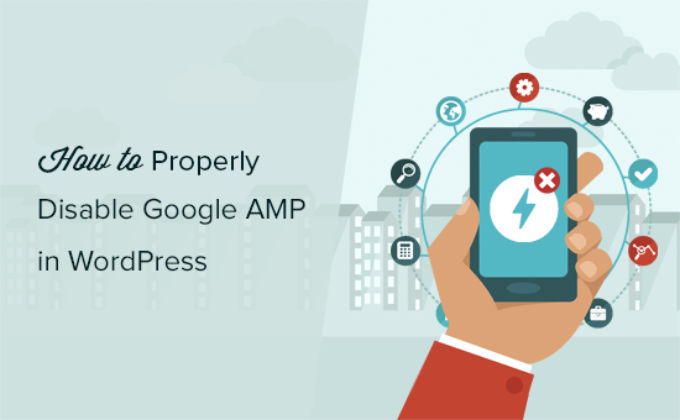
Por qué deberías desactivar Google AMP en WordPress
Accelerated Mobile Pages (AMP) es una iniciativa de código abierto para hacer la web más rápida para los usuarios móviles y mejorar la experiencia de usuario.
Lo hace sirviendo páginas con un mínimo de HTML y JavaScript. Esto permite que el contenido se aloje en la caché de Google AMP. Google puede entonces servir esta versión en caché a los usuarios de forma instantánea cuando hacen clic en tu enlace en los resultados de búsqueda.
Sin embargo, si ha optado por establecer Google AMP en WordPress, es posible que sienta que ha tomado la decisión equivocada.
No eres el único. Muchos propietarios de sitios web, personas influyentes y publicaciones en línea han dejado de usar AMP en sus blogs de WordPress.
En primer lugar, vamos a repasar por qué puede considerar desactivar AMP en su sitio web de WordPress, y luego le guiaremos a través del proceso.
Google Analytics 4 no es compatible con AMP
Google Analytics 4 o GA4 es la última versión de Google Analytics que realiza el seguimiento de su sitio web y aplicaciones móviles en la misma cuenta. Aporta muchos cambios, como nuevos métodos de seguimiento, características de los informes, métricas e informes.
Entre estos cambios se encuentra que GA4 no es compatible con AMP de forma oficial por el momento, y no se ha confirmado si funcionará en el futuro. Uno de los motivos es que realiza un seguimiento de los visitantes de tu sitio web y de tu aplicación en la misma propiedad.
Sin embargo, Google ha dicho que solo podrás acceder a los datos antiguos durante al menos 6 meses. Esto significa que todavía puedes acceder a los informes de Universal Analytics para ver los datos anteriores, pero aún no podrás realizar el seguimiento en la versión más reciente.
Caída drástica de las tasas de conversión
Google AMP establece muchas restricciones en HTML/JavaScript. Esto significa que muchos elementos interactivos de tu sitio web de WordPress faltan con AMP, como los formularios de suscripción y los mensajes / ventanas emergentes de salida.
Como resultado, los propietarios de sitios no pueden animar a los usuarios a suscribirse, rellenar formularios de contacto o comprar cosas.
Menor número de páginas vistas por usuarios móviles
AMP no muestra las barras laterales de tu sitio web ni otras características de descubrimiento de contenido. Esto provoca un descenso significativo de las páginas vistas por los usuarios móviles.
De hecho, algunos expertos en experiencia de usuario sugieren que el botón de cierre en la parte superior en realidad anima a los usuarios a volver a la búsqueda de Google después de leer su artículo en lugar de navegar por su sitio web.

Menor participación de los usuarios
Muchos sitios web prosperan gracias a las interacciones de los usuarios, como los widgets click-to-tweet, las valoraciones / puntuaciones de los usuarios, los comentarios, etc. Google AMP hace que sea bastante difícil para los propietarios de sitios web mantener la participación de los usuarios e interactuar con su contenido.
¿Debería desactivar Google AMP?
La respuesta a esta pregunta depende de su sitio web. Si los usuarios móviles constituyen la mayor parte de tu audiencia, puede que te interese utilizar AMP.
Por otro lado, si has probado Google AMP y ha afectado negativamente a tus tasas de conversión, entonces probablemente deberías desactivar Google AMP en tu sitio web.
Contrariamente a la creencia popular, Google no penaliza a los sitios web por no utilizar AMP. Aún puedes mejorar la velocidad y el rendimiento de tu sitio web en dispositivos móviles para competir por una audiencia de búsqueda móvil.
Con todo esto en mente, veamos cómo puedes desactivar AMP en tu sitio web WordPress.
Desactivar plugins de Google AMP en WordPress
No todo el mundo utiliza los mismos plugins de WordPress para añadir soporte AMP a sus sitios web. Sin embargo, los ajustes básicos siguen siendo los mismos independientemente del plugin que utilices.
Lo primero que tienes que hacer es desactivar cualquier plugin de AMP que tengas instalado.
Simplemente visite la página Plugins ” Plugins Instalados desde su escritorio de WordPress y haga clic en ‘Desactivar’ debajo del nombre del plugin AMP.
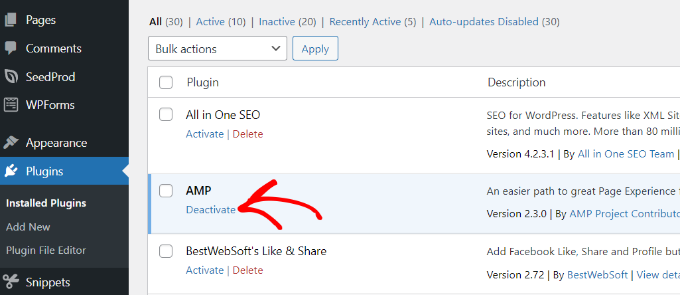
Basta con desactivar el plugin para desactivar el soporte de AMP en tu sitio web. Sin embargo, hay algunos pasos más a seguir para asegurarse de que su sitio está libre de AMP.
Establecer redireccionamientos para páginas AMP
Al desactivar el plugin de AMP se eliminará la versión AMP de tus artículos del sitio web. Sin embargo, eso solo no es suficiente, especialmente si tienes AMP activado durante más de una semana.
Es muy probable que Google ya tenga indexadas esas páginas y siga mostrándolas en los resultados de búsqueda. Si un usuario hace clic en una de ellas y usted la ha quitado de su sitio, se encontrará con una página 404, ya que ahora falta ese contenido.
Para corregir este problema, debe redirigir a los usuarios que llegan a las páginas AMP a las páginas normales que no son AMP.
Te mostraremos dos métodos diferentes para establecer redirecciones para Google AMP, primero usando un plugin y luego usando código. Puedes elegir el que más te convenga.
Método 1: Utilizar un plugin de redireccionamiento
La forma más sencilla de establecer la redirección en WordPress es utilizando el plugin All in One SEO (AIOSEO). Es el mejor plugin SEO para WordPress que ofrece una potente gestión de redirecciones.
Tenga en cuenta que necesitará la licencia AIOSEO Pro porque incluye el gestor de redirecciones.
En primer lugar, deberá instalar y activar el plugin All in One SEO (AIOSEO). Para más detalles, consulta nuestra guía paso a paso sobre cómo instalar un plugin de WordPress.
Una vez activado, puede ir a All in One SEO ” Redirecciones desde el escritorio de WordPress y hacer clic en el botón ‘Activar redirecciones’.
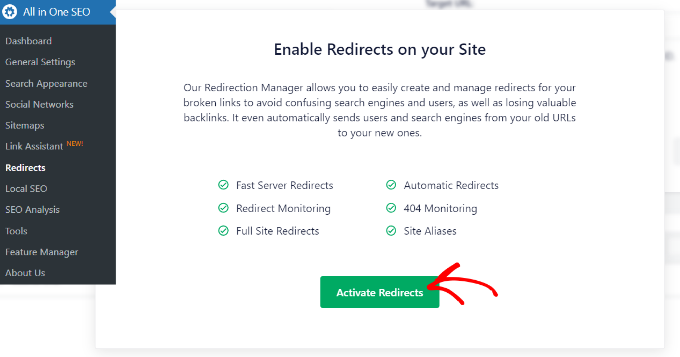
Esto le ayudará a instalar la extensión AIOSEO Redirection Manager que gestiona esta característica. Una vez activado, accederá a la pestaña “Redirecciones”. Aquí puede introducir las URL de origen y destino para establecer la redirección.
En primer lugar, deberá hacer clic en el icono “Engranaje” del campo URL de origen y, a continuación, activar la casilla de verificación “Regex”.
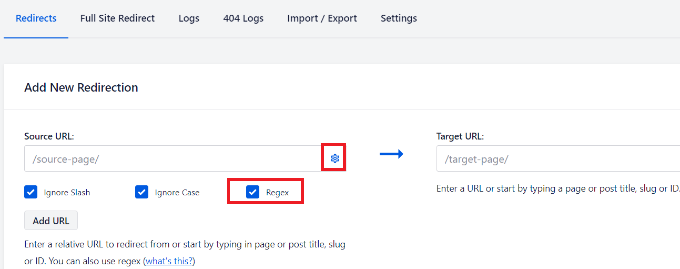
A continuación, puede añadir el siguiente código en el campo Source URL:
^/(.*)\/amp
En el campo URL de destino, debe añadir la URL de su sitio web con el siguiente formato:
https://example.com/$1
No olvide sustituir “ejemplo.com” por su propio nombre de dominio.
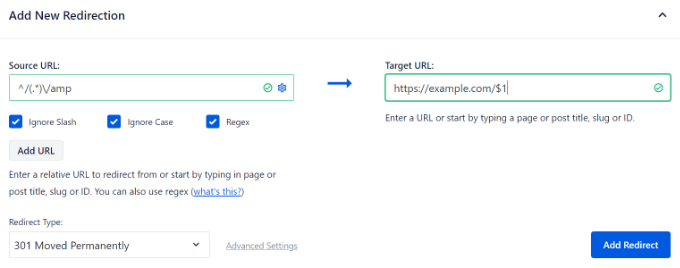
A continuación, puede mantener el ‘Tipo de redirección’ como 301 Movido permanentemente. De esta forma, sus usuarios serán redirigidos permanentemente a las páginas no AMP.
Por último, haga clic en el botón “Añadir redirección” para guardar los cambios.
Ahora puedes visitar la URL de una antigua página AMP de tu sitio web para comprobar si la redirección funciona correctamente.
AIOSEO también le ayuda a realizar un seguimiento de los enlaces rotos de su sitio web. Puedes identificar rápidamente las páginas AMP que dan lugar a errores 404 y redirigirlas. Para obtener más información, consulta nuestra guía sobre cómo realizar un seguimiento de las páginas 404 y redirigirlas en WordPress.
Método 2: Establecer manualmente las redirecciones en .htaccess
Si no desea utilizar un plugin para establecer las redirecciones, puede configurarlas utilizando el archivo .htaccess de su cuenta de alojamiento de WordPress.
En primer lugar, deberá conectarse a su sitio web mediante un cliente FTP o el gestor de archivos de cPanel. Para más detalles, consulte nuestra guía sobre cómo utilizar FTP para subir archivos en WordPress.
Una vez conectado, deberá localizar el archivo .htaccess en la carpeta raíz de su sitio web.

A continuación, puede editar el archivo en su carpeta raíz.
A continuación, sólo tiene que añadir el siguiente código en la parte inferior de su archivo .htaccess:
// Redirect AMP to non-AMP
RewriteEngine On
RewriteCond %{REQUEST_URI} (.+)/amp(.*)$
RewriteRule ^ %1/ [R=301,L]
No olvide guardar los cambios y volver a subir el archivo a su servidor.
Ahora puedes visitar la URL de la antigua versión AMP de cualquier entrada de tu sitio web para asegurarte de que la redirección funciona correctamente.
Esperamos que este artículo te haya ayudado a desactivar correctamente Google AMP en WordPress. Puede que también quieras ver nuestra guía SEO paso a paso para principiantes y los mejores consejos para acelerar WordPress.
If you liked this article, then please subscribe to our YouTube Channel for WordPress video tutorials. You can also find us on Twitter and Facebook.





Syed Balkhi says
Hey WPBeginner readers,
Did you know you can win exciting prizes by commenting on WPBeginner?
Every month, our top blog commenters will win HUGE rewards, including premium WordPress plugin licenses and cash prizes.
You can get more details about the contest from here.
Start sharing your thoughts below to stand a chance to win!
Adeel Qadir says
Thanks for such a nice article and your way of explaining was very simple. With this helpful article, I have easily redirected my website and remove AMP successfully.
Lots of thanks
WPBeginner Support says
You’re welcome, glad our guide was helpful
Administrador
Parkashjit Singh says
Hi Sir, i following all the steps but, i saw all the amp link on google which are ranked now how i can removed that amp ranked links on google. As well when i search on google about my site then i saw amp logo after my site tittle even now I’m not using apm. Now how i removed that icon.
WPBeginner Support says
You would need to have Google recrawl your site to start removing the content from Google’s search results.
Administrador
Parkashjit Singh says
How, is there any tutorial or bog. Please send me
WPBeginner Support says
You can find our article on how to do this below:
https://www.wpbeginner.com/wp-tutorials/how-to-ask-google-to-recrawl-urls-of-your-wordpress-site/
Raj Deep says
My site uses ssl and is on https. Should I use https or http in the redirection ?
WPBeginner Support says
Use HTTPS
Administrador
Robin says
Hey I have page which have /?amp AMP format. So what change I have to do for proper redirection,
As the code given above /(.*)\/amp is only redirection pages with /amp.
Please tell me what change required for this ? thing.
WPBeginner Support says
You could create an additional redirect where you add * before amp if you customized your amp URLs to show like that.
Administrador
Bob Morris says
Thanks. I found this article after one too many posts with 17 indecipherable AMP errors
WPBeginner Support says
Glad our guide could be helpful
Administrador
Farblos Kay says
This is the best website to learn and fix anything WordPress. You guys are geniuses!
WPBeginner Support says
Thank you, glad you find our content helpful
Administrador
Subodh Gupta says
I have disabled AMP on my site using the mentioned codes. But the post/page previews are showing in AMP mode. What to do? Using TagDiv NewsPaper theme.
WPBeginner Support says
You would want to ensure you’ve cleared all of your caching for the most common reason for that.
Administrador
Adnan says
Yours AMP pages are in Google cache, so when Google Bot re-index and check no rel=”amphtml” tag they index non-AMP page.
Julia says
Hi, this article sounds very useful, thanks for sharing!
Before I will deactivate/uninstall AMP plugin as well, I have to ask a question.
I have, by mistake, redirected few of amp links (with amp plugin already installed) to my normal url link:
example.com/amp to example.com
The reason why I did that redirect with redirection plugin, is that I had no knowledge of what amp is, and so I thought it’s an error, when I was migrating my site.
Now my question is, should I rather disable all my redirects with amp and then disable/uninstall the AMP plugin and then do the bulk redirect ?
Thank you for your help!
WPBeginner Support says
To be safe you may want to create an export of your current redirects, remove them, then do the method in this article to prevent the possibility of multiple redirects
Administrador
Pratik Bhatt says
Hi,
Can you tell me, when we can remove the redirection plugin. Does google remove the amp pages automatically after some time?
WPBeginner Support says
Once the amp pages are no longer being indexed you can remove the redirection. It takes time and Google recrawling your site for the links to be removed.
Administrador
Pratik Bhatt says
Thanks for the quicky reply.
One more question, I’ve to ask, If I don’t do the redirection, then still google remove the amp pages after some time?
Thanks.
WPBeginner Support says
Eventually yes
sam says
Hi
I followed the steps above. However, when searching on my mobile device the amp pages are still popping up (It’s only been a few hours so this may be why). When I search on desktop device and type in domain.com/amp the redirect works perfectly. Do you know why this is happening?
WPBeginner Support says
You would need to clear any caching as the most common reason it would still be showing up.
Administrador
Kuldeep Singh says
Worked like a charm.
Thanks!
WPBeginner Support says
Glad our guide was helpful
Administrador
Jason says
Great Guide! Worked like a charm.
WPBeginner Support says
Thank you, glad our guide was helpful
Administrador
ahs shaikh says
thank you very much for this blog post…
WPBeginner Support says
You’re welcome
Administrador
Rahul sarawagi says
Hey,
I tried this way and now my website is not loading, it is giving an error message that
” redirected you too many times ”
Please help me out in getting it back.
WPBeginner Support says
For the too many redirects error, you would want to take a look at our guide here: https://www.wpbeginner.com/wp-tutorials/how-to-fix-error-too-many-redirects-issue-in-wordpress/
Administrador
Dietrich says
I have done method 1 and cleared/deleted cache and it still shows the AMP version? Any tips how to fix?
WPBeginner Support says
You would want to check that your host does not have caching enabled and your redirects do no have any typos
Administrador
Rohit verma says
i have done the first method but it still shows amp version what to do?
WPBeginner Support says
You would want to clear any caching as the most likely cause
Administrador
Subham says
Hi,
You guys are doing great.
After creating AMP i have seen down in my traffic.
So i decided to remove that and i did.
I got many errors. So, i had to install amp again.
Now finally this article helped me a lot to completely remove amp.
Thank you very much WPbeginner.
You are a lifesaver!
WPBeginner Support says
Glad our guide could be helpful
Administrador
Catherine Thomas says
THANK YOU!!!! Method #1 worked perfectly!!!
WPBeginner Support says
Glad our recommendations could help
Administrador
Akash Gogoi says
Can I disable redirection plugin after AMP completely gone from Google search result? Please help.
WPBeginner Support says
If you would like you can. Be warned that would remove the redirects so if the links start appearing as broken links in your search console you may need to readd the redirects.
Administrador
Enes says
Hey. Thank you very much for the info but i had a question. It does not work with me method 1. it suppose to be non amp as soon as i do redirect right ?
my website is https so i made it as https that what it should be ? Thanks in advance
WPBeginner Support says
If you are using https then you would want the second field as https, as long as you don’t have caching then it should automatically update. If not, you would want to reach out to the plugin’s support for them to take a look.
Administrador
Suanlian Tangpua says
When should I remove the redirection?
WPBeginner Support says
As it would depend on if Google still links to your AMP pages, we don’t have a set time to remove it we would recommend at the moment.
Administrador
Hiral says
Hi, thanks for helping. I used method 1. All the blog posts are being displayed in proper format but home page, about, contact such pages are still being displayed in AMP. How to fix it?
WPBeginner Support says
You may want to check with the author of the redirection plugin to ensure there isn’t a hiccup with the created redirect.
Administrador
Elsaid says
Thanks a lot
Now I disable and delete AMP Plugin. and redirect lINKS by first method.
but I have a question , If I want reinstall AMP plugin again
what I should do about redirections????
WPBeginner Support says
You would need to remove the redirections.
Administrador
Kumarpal Shah says
I’ve used Method 1 – Using Redirection Plugin. Now, my question is after adding the redirection is it necessary to keep plugin installed & activated?
OR I can remove the plugin after adding the redirection?
WPBeginner Support says
Using the plugin, you would need to keep the plugin active for the redirects to continue.
Administrador
Mario says
It worked for me wpbeginner thanks a lot
Amp is not advisable use
WPBeginner Support says
Glad our article could help
Administrador
foodstyling says
Hi,
I used the redirection method and the AMP pages are redirected to fine, but the address remain as /?amp.
Should I worry?
WPBeginner Support says
If the redirection is working correctly, then you do not need to worry about the urls.
Administrador
Mark Llego says
I would like to know how can I 301 redirect if my amp url is structured like this
site.com/amp/your-article/
I am using better amp.
Thank you.
WPBeginner Support says
Hi Mark,
The htaccess method in this post should handle that redirect for you
Administrador
Joanna says
Thank you so much! I was struggling with accidentally adding AMP pages and then removing them to losing a lot of traffic. Then, I felt defeated, so I reinstalled AMP. Method 1 with the Redirection plug-in was so easy I wish I had seen this sooner. THANKS!!
WPBeginner Support says
Glad our article could help
Administrador
Rajesh Ranjan says
hii, i followed each and every step but its not working on my WordPress website.
WPBeginner Support says
If you removed AMP completely and clearing your cache did not remove the AMP versions you may want to check with your hosting provider to ensure they don’t have caching or similar that would be affecting the AMP pages.
Administrador
Margaret says
I’m using the Yoast plugin for redirects – what do I input and where to redirect my amp urls to my non-amp ones?
Manh Nguyen says
I do as instructed, how long does my site return to normal ?
Thanks!
katie larking says
Hi I disabled the AMP plugin and set up a redirect as per the article. The redirect works, but the AMP pages are still in google index and working. How long until google replaces them with my non amp pages. Please let me know how long it takes organically vs anything I can do to speed this up that is proven to work. Thankyou!
Aaron Hunter says
This helped so much thank you! I’ve asked WP support, and they had nothing to offer me for a solution. The new version of WordPress.com doesn’t let you deactivate AMP so I used the Redirection plugin. Thank you again!!!
Keith Whitworth says
You are an absolute lifesaver! After implementing AMP, my user engagement dropped significantly, my site links in Google totally disappeared, my ranking (for my niche) was at the bottom of the barrel.
AMP is not really designed for podcasts AT ALL.
Once I decided it wasn’t going to work out, I deleted the plugin only to generate thousands of 404 errors related to AMP. I found myself creating unnecessary laborious work creating redirects every day as they popped up.
Finally, I got frustrated and performed a search and replace in my database to remove amp/ which was a massive mistake. Suddenly my site was no longer available. I deleted the plugin and everything was restored but what to do about all the 404 errors related to AMP?
I ran across your website through a Google search and presto. In one fell swoop, all my headaches disappeared. My sitelinks have been restored and yesterday I received an email from Google stating that mobile-first indexing was enabled on my site.
I cannot thank you enough!
WPBeginner Support says
Hi Keith,
We are glad you found the article helpful You may want to join us on Twitter for more WordPress tips and tutorials. Next time you come across an issue, don’t forget to search WPBeginner first for a solution
You may want to join us on Twitter for more WordPress tips and tutorials. Next time you come across an issue, don’t forget to search WPBeginner first for a solution 
Administrador
virginia says
and a little question, after deactivating AMP, can I delete it? is it safe to do so?
WPBeginner Support says
Hi Virginia,
Yes, it is safe to delete the AMP plugin.
Administrador
virginia says
hi, I`ve been using AMP but it generated a lot of errors in Google Search console. I´m an amateur blogger so I can´t identify properly the reasons when something isn´t working.
A thing I´ve noticed with AMP is that they cherrypick which image they show as your featured image in a blogpost, and it´s NEVER your actual featured image!! they choose to show an image uploaded inside the body of the post. And I run a travel blog, so I have a lot of unattractive -but useful- images like “this is the almost-hidden-kiosk where you can buy tickets to Eiffel Tower for less”. Well..they decided to show THOSE images instead of my well-curated eye-catching images featuring each post… It´s a NO- NO !!
By the way I was affected by the Yoast SEO bug early this year (which erased the no-index labels in media files, so if someone googled my blog, random images -like pie charts- showed in the results AS PAGES and posts in my blog without a single word explaining anything… a nightmare). I´ve installed a plugin called “404 redirect” to get rid of that mess, redirecting images to actual posts. It´s working fine as much as I know!
I´m trying to redirect all my /amp pages to the original URL, but a few days ago they changed the way the /amp pages show in browsers… is isn´t anymore /blogname.com/posttitle/amp Where can I find my amp pages to copypaste them and redirect all of them to my proper URLs?
Great article! Thank you for giving me more valid reasons to unistall AMP.
Tom Darche says
I used another regex based on this one:
/(.*)\/amp?\/
My regex match the same but also match “something-before/amp/ instead of only “something-before/amp”
Natalie says
Hi, thanks for this. I have been following an alternative method which tries to remove all AMP URLS by labelling them as no index. This uses the real-time find and replace plugin… where you add this code to the find section of the plugin:
You then go to the AMP plugin, go to the SEO section and add the following code to the head section: The idea is, that this will then signal google to take your amp pages out of the search. It’s only been a couple of days, but google has only indexed more AMP pages so far, so I’m not sure if it’s going to work. You can then create a 404 redirect if you wish from AMP pages to non-amp urls. Only at this point do you disable the AMP plugin. Do you think this will work? I’m trying my best to do this without damaging my rankings. Also…. one more thing! Since installing AMP my traffic has dropped by around a third according to analytics. Is this just because google analytics is not registering visits to AMP pages? I did put my google analytics code in when I set up Google AMP, but that’s all I did, I didn’t add anything to analytics otherwise. Thank you!!
Sarah Carter says
Thanks, very easy to follow. I’m adding in another reason to disable amp (I’ve been on the fence for a while), is that the Amazon affiliate link builder program does NOT support AMP, neither domany of the cookie plugins that folks have been using for GDPR compliance purposes.
Ross Graham says
Exactly the same reason I dropped AMP. even when promoting my site and sharing direct page links many of my users still ended up on none AMP pages. I lost revenue and now My site is back to costing me money instead of earning me money. I could still see people are converting and clicking my links but yesterday when i had a huge boost in traffic, out of 500 link clicks, only 33 were captured by my affiliate programme.
Mirre says
Thanks that was so easy!!
Simson says
An hour ago I was on the page, how to install AMP. After setting up and going through some of the folks’ articles, I’m here.
Dan says
I tried both methods and they don’t work
The .htaccess method causes a server error.
While the redirect method doesn’t work.
I use the plugin Yoast SEO, and they have Regex redirects but it won’t work for me.
Please help!
Aniket Bangar says
Hi Dan,
Try
# Redirect AMP to non-AMP
RewriteEngine On
RewriteCond %{REQUEST_URI} (.+)/amp(.*)$
RewriteRule ^ %1/ [R=301,L]
I am sure you also copied the comment “/Redirect AMP to non-AMP ” which caused500 error
James Michael Sama says
Hey there – I’m getting about 100k uniques per month from search traffic and turning off AMP because people aren’t subscribing – so thank you for this.
Quick question: Do I need to redirect every specific page URL from the AMP ones? There are about 800 articles on my site, and that would take forever.
I appreciate it!
– James
WPBeginner Support says
Hi James,
Using the redirection plugin will automatically redirect all AMP URLs to regular ones.
Administrador
Ashraf Jan says
Thank you So Much dear…..!!! Will it affect Search traffic and AdSense?
Kane says
Thanks a lot for this tutorial. another reason why it makes sense to disable google amp on your wordpress is the use of adsense. dynamic adsense ads will not roll out on amp pages.
Have you had any experiences on this?
Totally weird, as this is the way how google acutally earns money…
Manoj says
Thanks for your detailed guidance. It’s really helpful. In the same way, how can I redirect users from my old permalink structure to the new structure? I was using http://www.example.com/month/sample-post permalink on the blog, later I changed it to http://www.example.com/post-name.
G. P. Gautam says
Hi,
I have activated AMP for my website. And its been long time to set it up. Now I want to Disable AMP for my site. That is why I am following this guide. I do the same as you mention in method 2. When I save my .htaaccess file it shows me this message, “501 internal server error.”
What is this and how to solve this problem.
Please guite.
WPBeginner Support says
Hi,
Please see our guide on how to fix internal server error in WordPress.
Administrador
Emily Brown says
Thanks for the great post. It is very helpful.
Kevin says
I have done as you said above and added in the plugin, I have deactived the amp plugin but the redirect didn’t work. Google still sends me to the amp page.
My website is and I added /$1 after as above.
I put https instead of http as above. Have tried both ways.
Does it take time for google to get the redirects?
Any help would be great. My bouce rate is now at 70% and I think it is because of the Amp, it was about 20%
Thanks
WPBeginner Support says
Hi Kevin,
Yes. Your site’s AMP pages are hosted and served from Google’s own cache. They will continue to appear in search results until Google crawl backs your site. This may take a few days, you can also initiate a crawl using Google Search Console (webmaster tools).
Administrador
Ben says
The best reason, your content should be your content you should not give Google the power to shut you off